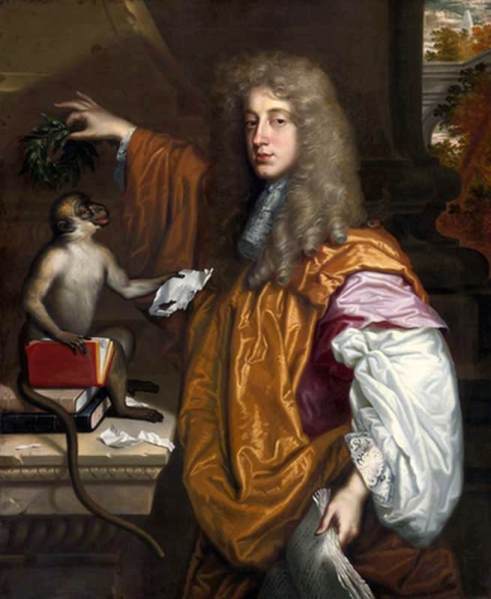Part two of Nothing
When Lord Rochester, the Restoration satirist, poet, libertine, courtier, and acting coach, wanted to make a visual satire on human vanity and transience, he avoided the 17th century’s skull cliché by being portrayed with a monkey offering him a page torn from a book, the descendant of the million virtual monkeys typing out Shakespeare’s plays.

Jacob Huysmans, John Wilmot, 2nd Earl of Rochester (1647 – 1680), oil on canvas. Private collection. Image: WGA Rochester, the most glamorous, and lighthearted, of obscene immoralists, collaborated with the Roman Catholic Flemish painter Jacob Huysmans to produce an iconic image mocking the ignorance and pretentiousness of mankind.
He isn’t patronising the monkey; he rated animal instinct higher than human nature, including his own, and his specific targets were the ruling class of which he was a member by birth, and everyone who presumed to exert power over other people, by force or by creed.
Like the other great privileged literary rebel, Byron, he inherited titles, property and a Cavalier heritage without any money, the lifeblood of power in society.
Rochester’s father was a hard-drinking, Anglo-Irish Cavalier officer, of the clubbable “Laughing” kind, committed to upholding monarchy, “his mother a strict Puritan; out of their union, the great disbeliever was born.
Rochester’s portrait also happens to be one of the most seductive images of male beauty, enhanced by androgynous Restoration fashion, which has glamourized the popular perception of libertines and nihilism ever since. We’d all be enrolling in metaphysics classes if the lecherous lecturer looked like that.
We might even dare go into the darkness some of us fear, to read erotic fiction and obscene verse, because Rochester makes sex feel like love.
Like the actor who played the rake-hell Willmore, based on Rochester, in a revival of Aphra Behn’s The Rover in the 1690s, “he made vice so alluring” to even the virtuous Queen Mary II.
Even the most sincere of critics of human nature cannot shake off his own self-consciousness. By showing himself in a portrait as a freethinker crowning, or more likely decrowning, a monkey, he was declaring how much more hip he was than everyone else at court and in the country.
He was right, of course – he’s a sex symbol who still makes hearts throb faster today, a prototype Romantic, by turns lyrical or obscene, depending on his hangover; one of the great tortured, self-destructive, witty, bisexual, substance-abusing, rocking and rolling anti-heroes who lived in the moment because time before and after is a fantasy, a trick of the mind’s eye, a waste of living.
Monkeys were popular pets among 17th century cosmopolitan aristocrats with brains and attitude – Charles I’s nephew, Prince Rupert, had kept one during the Civil War a generation earlier, “a malignant she-monkey” which the Roundheads made crude allegations about.
When their propagandists alleged she was a witch in disguise with whom the German prince was having sex, they were serving the public an inflammatory potion of minor royalty, xenophobia, superstition, and prurience –
That monkey won’t stop jumping about – it’s run away with the theme of this post – I can’t catch it – where has it gone?
The journey into Nothing will be continued….